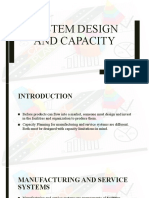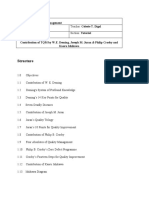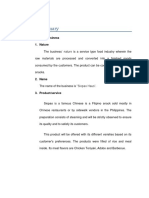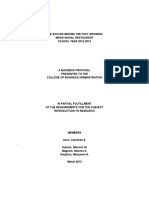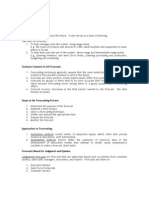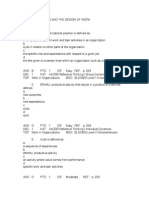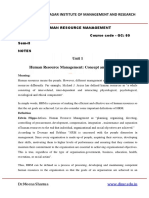Chapter 7 - Design of Work Systems
Chapter 7 - Design of Work Systems
Uploaded by
hello_khayCopyright:
Available Formats
Chapter 7 - Design of Work Systems
Chapter 7 - Design of Work Systems
Uploaded by
hello_khayOriginal Description:
Original Title
Copyright
Available Formats
Share this document
Did you find this document useful?
Is this content inappropriate?
Copyright:
Available Formats
Chapter 7 - Design of Work Systems
Chapter 7 - Design of Work Systems
Uploaded by
hello_khayCopyright:
Available Formats
Chapter 7 DESIGN OF WORK SYSTEMS OPERATIONS STRATEGY It is important for management to make design of work systems a key element
of its operations strategy. In spite of the major advances in computers and manufacturing technology, people are still the heart of a business; they can make or break it, regardless of the technology used. Technology is important, of course, but technology alone is not enough. The topics described in this chapter job design, methods analysis, motion study, work standards, and incentives all have an impact on productivity. They lack the glamour of high tech; they are closer to the back-to-the-basics fundamentals of work improvement. Workers can be a valuable source of insight and creativity because they actually perform the jobs and are closer to the problems that arise. All too often, managers have overlooked contributions and potential contributions of employees, sometimes because of ignorance and sometimes because of a false sense of pride. Union management differences are also a factor. More and more, though, companies are attempting to develop a spirit of cooperation between employees and managers, based in part on the success of Japanese companies. In the same vein, an increasing number of companies are focusing some of their attention on improving the quality of work life and instilling pride and respect among workers. Many organizations are reaping surprising gains through worker empowerment, giving workers more say over their jobs. People work for a variety of reasons. Economic necessity is among the most important, but beyond that, people work for socialization, to give meaning and purpose to their lives, for status, for personal growth, and for other reasons. These reasons can play an important role of the lives of workers and should be accorded serious consideration in the design of work systems.
Job Design. The act of specifying the contents and methods of jobs. The goal of job design is to create a work system that is productive and efficient, taking into consideration of costs and benefits of alternatives for the organizations and the workers. Successful job design must be: 1. Carried out by experienced personnel who have the necessary training and background. 2. Consistent with the goals of the organization. 3. In written form. 4. Understood and agreed to by both management and employees. Current practice in job design contains elements of two basic schools of thought. One might be called the efficiency school because it emphasizes a systematic, logical approach to job design; the other is called the behavioral school because it emphasizes satisfaction of needs and wants. Specialization. Work that concentrates on some aspect of a product or service. Behavioral Approaches to Job Design Job enlargement. Giving a worker a larger portion of the total task, horizontal loading. Job rotation. Workers periodically exchange jobs. Job enrichment. Increasing responsibility for planning and coordination tasks, by vertical loading.
Self-directed teams. Empowered to make certain changes in their work processes. The benefits of teams include higher quality, higher productivity, and greater worker satisfaction. Methods Analysis The need foe methods analysis can come from a number of difference sources: 1. Changes in tools and equipment. 2. Changes in product design, or new product. 3. Changes in materials or procedures 4. Government regulations or contractual agreements. 5. Other factors such accidents and quality problems The basic procedure in method analysis is: 1. Identify the operation to be studied, and gather all pertinent facts about tools, equipment, materials, and so on. 2. If the job is currently being done, discuss the job with the operator and supervisor to get their input. 3. Study and document the present method of an existing job using process charts. For new jobs, develop charts based on information about the activities involved. 4. Analyze the job. 5. Propose new methods. 6. Install the new methods. 7. Follow up installation to assure that improvements have been achieved. Selecting an Operating to Study. 1. Have a high labor content. 2. Jobs are done frequently. 3. Jobs are unsafe, tiring, unpleasant, and/or noisy. 4. Jobs are designated as problems Documenting the Present Method Use charts, graphs, and verbal descriptions of the way the job is now being performed. Analyzing the Job and Proposing New Methods Flow process chart. Chart used to examine the overall sequence of an operation by focusing on movements of the operator or flow of materials. Worker-machine chart. Chart used to determine portions of a work cycle during which an operator and equipment are busy or idle. Installing the Improved Method Successful implementation of proposed method changes requires convincing management of the desirability of new method and obtaining the cooperation of the worker. The Follow-up In order to ensure that changes have been made and that the proposed method is functioning as expected, the analyst should review the operation after a reasonable period and consult again with the operator. Motion Study. Systematic study of the human motion used to perform an operation. The purpose is to eliminate unnecessary motions and to identify the best sequence of motions for maximum efficiency. The most-used techniques are: 1. Motion study principles. Guidelines for designing motion-efficient work procedures. a. Eliminate unnecessary motions b. Combine activities c. Reduce fatigue d. Improve the arrangement of the workplace
e. Improve the design of tools and equipment 2. Analysis of therblings. Basic elemental motions into which a job can be broken down. a. Search implies hunting for an item with the hands and/or the eyes. b. Select means to choose from a group of objects. c. Group means to take hold of an object. d. Hold refers to intention of an object after it has been grasped. e. Transport load means movement of an object after hold. f. Release load means to deposit the object. 3. Micromotion study. Use of motion pictures and slow motion to study motions that otherwise would be too rapid to analyze. 4. Charts. Simo charts can be used to study simultaneous motions of the hands. Working Conditions 1. Temperature and Humidity. 2. Ventilation 3. Illumination 4. Color a. Effects of colors on mood and feelings b. Visual discriminations c. Designate safe or hazardous areas 5. Noise and Vibration 6. Work Breaks 7. Safety There two basis causes of accidents are worker carelessness and accident hazards. OSHA. Occupational Safety and Health Act of 1970; Occupational Safety and Health Administration. Work Measurement Job design determines the content of a job, and methods analysis determines how a job is to be performed. Work measurement is concerned with determining the length of time it should take to complete job. Job times are vital inputs for manpower planning, estimating labor costs, scheduling, budgeting, and designing incentive systems. Standard time. The amount of time it should take a qualified worker to complete a specified task, working at a sustainable rate, using given methods, tools and equipment, raw materials, and workplace arrangements. The most commonly used methods of work measurements: 1. Stopwatch time study. Development of a time standard based on observations of one worker taken over a number of cycles. Steps: a. Define the task to be studied, and inform the worker who will be studied. b. Determine the number of cycles to observe. c. Time the job, and rate the workers performance. d. Compute the standard time. Several reasons: a. Some elements are not performed in every cycle, and the breakdown enables the analyst to get better perspective on them. b. The workers proficiency may not be the same for all elements of the job. c. To build a file of elemental times that can be used to set for other jobs. The number of cycles that must be timed is a function of three things: 1. the variability of observed times 2. desired accuracy 3. desired level of confidence for the estimated job time
The sample size needed to achieve that goal can be determine using this formula: n = (zs/ax)2 where z number of normal deviations needed for desired confidence s sample standard deviation a desired accuracy percentage x sample mean An alternate formula used when the desired accuracy is stated as an amount instead of a percentage: n = (zs/e) 2 where e accuracy or maximum acceptable error s = (xi x)2 / n 1 or s = [ x2i - ( xi)2 / n] / n 1 Development of time standard involves computation of three times: a. Observed time is simply the average of the recorded times. OT = xi / n Where OT observe time xi sum of recorded times n number of observations b. Normal time is the observed time adjusted for worker performance. NT = OT x PR Where NT normal time PR performance rating This assumes that a single performance rating has been made for the entire job. NT = (xj x PRj) Where xj average time for element j PRj performance rating for element j c. Standard time. Normal time is the length of time worker should take to perform a job if there are no delays or interruptions. ST = NT(1 + A) Where ST standard time A allowance percentage based on job time 2. Historical times Standard elemental times. Time standards derived from a firms historical time data. The procedure for using standard elemental times consists of the following steps: a. Analyze the job to identify the standard elements. b. Check the file for elements that have historical times, and record them. Use time study to obtain others, if necessary. c. Modify the file time if necessary. d. Sum the elemental times to obtain the normal times, and factor in allowances to obtain the standard time. Advantages: a. Potential approach savings in cost and effort created by not having to conduct a complete time study for each job.
b. There is less disruption of work c. Performance ratings do not have to be done; they are generally averaged in the file times. Disadvantage: a. Times may not exist for enough standard elements to make it worthwhile, and the file times may be biased or inaccurate. 3. Predetermined data Predetermined time standards. Published data based on extensive research to determine standard elemental times. A commonly used system is methods-time measurement (MTM). Advantages: 1. They are based on large numbers of workers under controlled conditions. 2. The analyst is not required to rate performance in developing the standard. 3. There is no disruption of the operation. 4. Standard can be established even before a job is done. 4. Work sampling Work sampling. Technique for estimating the proportion of time that a worker or machine spends on various activities. e = p(1-p) / n where z number of standard deviations needed to achieve desired confidence p sample proportion n sample size Steps: 5. Clearly identify the worker and machines to be studied. 6. Notify the workers and supervisors of the purpose of the study to avoid arousing suspicions. 7. Compute an initial estimate of sample size using a preliminary estimate of p, if available. 8. Develop a random observation schedule 9. Begin taking observations. Recomputed the required sample size several times during the study. 10. Determine the estimated proportion of time spent on the specified activity Random number table. Table consisting of unordered sequences of numbers, used to determine random observation schedules. Compensation Organizations use two basic systems for compensating employees: 1. Time-based system. Compensation based on time an employee has worked during a pay period. 2. Output-based system. Compensation based on amount of output an employee produced during a pay period. The incentive plan should be; 1. Accurate 2. Easy to apply 3. Consistent 4. Easy to understand 5. Fair Incentive system may focus on the output of each individual or on that of a group.
Knowledge-based pay. A pay system used by organizations to reward workers who undergo training that increases their skills.
You might also like
- Full Download:: Test BankDocument16 pagesFull Download:: Test BankRohan Dwivedi100% (2)
- Chapter 4 - Workforce FocusDocument9 pagesChapter 4 - Workforce FocusShaina Trish Taguiam100% (2)
- Product and Service DesignDocument25 pagesProduct and Service DesignRonaldo Convento100% (1)
- Importance of Strategic Human Resource ManagementDocument14 pagesImportance of Strategic Human Resource ManagementAngelo VillalobosNo ratings yet
- Chapter 3 Designing and Analyzing Jobs: Management of Human Resources, 5e (Dessler Et Al.)Document20 pagesChapter 3 Designing and Analyzing Jobs: Management of Human Resources, 5e (Dessler Et Al.)azade azami100% (1)
- Case Study - Outsourcing of The HospitalDocument5 pagesCase Study - Outsourcing of The HospitalBishnu Dhamala100% (1)
- System Design and CapacityDocument35 pagesSystem Design and CapacityAngelo RoqueNo ratings yet
- Chap 7 Design of Work SystemsDocument18 pagesChap 7 Design of Work Systemswhinwhin100% (4)
- in What WaysDocument4 pagesin What Waysmarie joy ortiz100% (1)
- Acct 3314 Assignment 1Document3 pagesAcct 3314 Assignment 1RCG92% (13)
- Profit Planning and CVP AnalysisDocument33 pagesProfit Planning and CVP AnalysisVanessa Claire MontalbanNo ratings yet
- TQMDocument4 pagesTQMDaniellaNo ratings yet
- Case BME 13Document5 pagesCase BME 13oo ngaNo ratings yet
- Chapter 9 - Management of QualityDocument11 pagesChapter 9 - Management of QualityHengyi Lim100% (2)
- Manufacturing and Nonmanufacturing CostsDocument18 pagesManufacturing and Nonmanufacturing CostsBoulos Albert100% (1)
- Chapter 11 - Inventory ManagementDocument7 pagesChapter 11 - Inventory Managementhello_khayNo ratings yet
- Many HR Activities Are Carried Out by SupervisorsDocument23 pagesMany HR Activities Are Carried Out by SupervisorsHarleen SandhuNo ratings yet
- OPMAN TOPIC 7 Part 2Document23 pagesOPMAN TOPIC 7 Part 2Ria BryleNo ratings yet
- Organizational Behaviour - MGT502 Power Point Slides Lecture 1Document38 pagesOrganizational Behaviour - MGT502 Power Point Slides Lecture 1Subika ArsalanNo ratings yet
- JollibeeDocument4 pagesJollibeeZaira50% (4)
- Quiz. For Ten (10) Points Each, Answer The Following Questions BrieflyDocument2 pagesQuiz. For Ten (10) Points Each, Answer The Following Questions BrieflyJohn Phil PecadizoNo ratings yet
- Process Selection and Facility LayoutDocument4 pagesProcess Selection and Facility LayoutClyde TorresNo ratings yet
- Aggregate Production PlanningDocument110 pagesAggregate Production Planningzakria100100No ratings yet
- Process Selection and Facility LayoutDocument53 pagesProcess Selection and Facility LayoutOsmaan GóÑÍNo ratings yet
- Quiz 2 AnswersDocument4 pagesQuiz 2 AnswersHana Demi DeeNo ratings yet
- Product Costing and PricingDocument27 pagesProduct Costing and Pricingcarlito alvarezNo ratings yet
- ENT - 1-Nature & Importance of EntrepreneursDocument25 pagesENT - 1-Nature & Importance of EntrepreneursMajhar Ul Haque100% (4)
- Operations Management Prelim Exam ReviewerDocument10 pagesOperations Management Prelim Exam ReviewerAlthea Santillan100% (1)
- 4 Aggregate PlanningDocument6 pages4 Aggregate PlanningNALLANKI RAJA KUMAR100% (2)
- Chapter 2 BLKDocument6 pagesChapter 2 BLKMinoo ShaikhNo ratings yet
- Final Case StoryDocument30 pagesFinal Case StoryMarilyn Claudine N. BambillaNo ratings yet
- Motosuit Marketing AuditDocument43 pagesMotosuit Marketing AuditMichelle Sevilla Cruz100% (1)
- Module 5 - Financial AspectDocument29 pagesModule 5 - Financial AspectJustin ManzanoNo ratings yet
- Feasibility Study: Chapter Three Market AnalysisDocument49 pagesFeasibility Study: Chapter Three Market AnalysisHabtamu AyeleNo ratings yet
- Implementing Strategies: Management & Operations IssuesDocument27 pagesImplementing Strategies: Management & Operations IssuesSemira muradNo ratings yet
- Supplement Ch05Document16 pagesSupplement Ch05michellefrancis26100% (1)
- Lecture 1 Introduction To Operations ManagementDocument20 pagesLecture 1 Introduction To Operations ManagementCleo de ChicoNo ratings yet
- Operations Management and Total Quality ManagementDocument43 pagesOperations Management and Total Quality ManagementAterg MooseNo ratings yet
- C.3 Technical Aspect Facilities and Equipment Table 5.A Machines and EquipmentDocument6 pagesC.3 Technical Aspect Facilities and Equipment Table 5.A Machines and Equipmentnaztig_017No ratings yet
- NGDelaVina Module CBMEC Chapter1 PDFDocument8 pagesNGDelaVina Module CBMEC Chapter1 PDFAmara Bless100% (2)
- Accounting For Materials QuestionsDocument2 pagesAccounting For Materials QuestionsMîñåk ŞhïïNo ratings yet
- Chapter 4 - Product and Service DesignDocument60 pagesChapter 4 - Product and Service DesignGio Mintu100% (6)
- Hazel CaseDocument18 pagesHazel CaseMj Gutierrez0% (2)
- TQM ReflectionDocument2 pagesTQM ReflectionKharl AnonuevoNo ratings yet
- Chapter 1: Intro To Operations ManagementDocument4 pagesChapter 1: Intro To Operations ManagementNicole OngNo ratings yet
- Chapter 4 - Product and Service DesignDocument4 pagesChapter 4 - Product and Service Designhello_khay100% (3)
- Location Planning and AnalysisDocument42 pagesLocation Planning and AnalysisSobhit Gupta67% (3)
- MachineryDocument20 pagesMachineryeulhiemae arongNo ratings yet
- Acunin, Arroyo, Aurelia, Dumot (Research Activity)Document14 pagesAcunin, Arroyo, Aurelia, Dumot (Research Activity)Angel Beluso DumotNo ratings yet
- LESSON 4 - Contribution of TQM by W.E. Deming, Joseph M. Juran & Philip CrosbyDocument27 pagesLESSON 4 - Contribution of TQM by W.E. Deming, Joseph M. Juran & Philip Crosbycelestetorino1No ratings yet
- FISHDUMPLINGDocument47 pagesFISHDUMPLINGPRINCE EIVANREN LUDOVICENo ratings yet
- Philosophies and FrameworksDocument26 pagesPhilosophies and Frameworksjo-738883100% (3)
- LSCM Quiz1Document2 pagesLSCM Quiz1Muhammad Adnan83% (6)
- Fs Technical StudyDocument8 pagesFs Technical StudyRenz Ian DeeNo ratings yet
- Chapter-4 Aggregate PlanningDocument22 pagesChapter-4 Aggregate PlanningYonatanNo ratings yet
- Executive SummaryDocument5 pagesExecutive SummaryVladimir MarquezNo ratings yet
- Linear Programming - ProblemsDocument2 pagesLinear Programming - ProblemsZeus Olympus50% (2)
- CHAPTER 8 - Aggregate Production PlanningDocument29 pagesCHAPTER 8 - Aggregate Production PlanningmeeyaNo ratings yet
- Aggregate Planning + MPS +capacity PlanningDocument21 pagesAggregate Planning + MPS +capacity PlanningAnoo PsNo ratings yet
- OM3 CH 14 Operations Scheduling and SequencingDocument15 pagesOM3 CH 14 Operations Scheduling and SequencingGanessa RolandNo ratings yet
- Krystal Guile Dagatan - Activity 2Document6 pagesKrystal Guile Dagatan - Activity 2Krystal Guile DagatanNo ratings yet
- Cost AccountingDocument12 pagesCost AccountingMakhzan Saleem100% (1)
- Chap 3 HW AssignmentDocument3 pagesChap 3 HW AssignmentBren OngNo ratings yet
- Chapter 5 Good HousekeepingDocument3 pagesChapter 5 Good HousekeepingKaye Joy Tendencia100% (1)
- Mang Inasal Feasibility StudyDocument27 pagesMang Inasal Feasibility StudyBayani Manalansan JarabaNo ratings yet
- Strategic Management The Challenge of The New CenturyDocument18 pagesStrategic Management The Challenge of The New CenturySalt N’ KookiezNo ratings yet
- Chapter Seven Work Design and MeasurementDocument7 pagesChapter Seven Work Design and MeasurementJohn Carlo TarlitNo ratings yet
- Om Ay2022 Ras 7Document22 pagesOm Ay2022 Ras 7justineinobacan58No ratings yet
- Coping With A Fluid RestrictionDocument9 pagesCoping With A Fluid Restrictionhello_khayNo ratings yet
- How Does Haemodialysis WorkDocument19 pagesHow Does Haemodialysis Workhello_khay100% (1)
- Prayer For A Good Husband or Wife: PersonDocument12 pagesPrayer For A Good Husband or Wife: Personhello_khayNo ratings yet
- Supplement To Chapter 9Document2 pagesSupplement To Chapter 9hello_khayNo ratings yet
- Supplement To Chapter 8Document2 pagesSupplement To Chapter 8hello_khayNo ratings yet
- Compressed - Download and Print Large Paper Rose Template PDFDocument13 pagesCompressed - Download and Print Large Paper Rose Template PDFMelinda Rose Fernandez100% (1)
- BSP Circ - No. 781 RbcarDocument37 pagesBSP Circ - No. 781 RbcarKesca GutierrezNo ratings yet
- Supplement To Chapter 4Document2 pagesSupplement To Chapter 4hello_khayNo ratings yet
- Supplement To Chapter 7Document2 pagesSupplement To Chapter 7hello_khayNo ratings yet
- Chapter 17 - Waiting LinesDocument4 pagesChapter 17 - Waiting Lineshello_khayNo ratings yet
- Chapter 15 - SchedulingDocument5 pagesChapter 15 - Schedulinghello_khayNo ratings yet
- Chapter 16 - Project ManagementDocument4 pagesChapter 16 - Project Managementhello_khayNo ratings yet
- Chapter 12 - Aggregate PlanningDocument4 pagesChapter 12 - Aggregate Planninghello_khay100% (2)
- Chapter 9 - Quality AssuranceDocument3 pagesChapter 9 - Quality Assurancehello_khayNo ratings yet
- Chapter 13 - Material Requirements PlanningDocument3 pagesChapter 13 - Material Requirements Planninghello_khayNo ratings yet
- Chapter 14 - Just in Time SystemsDocument4 pagesChapter 14 - Just in Time Systemshello_khayNo ratings yet
- Chapter 5 - Process Selection and Capacity PlanningDocument6 pagesChapter 5 - Process Selection and Capacity Planninghello_khay50% (2)
- Chapter 4 - Product and Service DesignDocument4 pagesChapter 4 - Product and Service Designhello_khay100% (3)
- Chapter 8 - Location PlanningDocument2 pagesChapter 8 - Location Planninghello_khayNo ratings yet
- Chapter 10 - ForecastingDocument7 pagesChapter 10 - Forecastinghello_khayNo ratings yet
- Chapter 1 - Production and Operations ManagementDocument4 pagesChapter 1 - Production and Operations Managementhello_khayNo ratings yet
- Chapter 3 - Quality ManagementDocument2 pagesChapter 3 - Quality Managementhello_khayNo ratings yet
- Taxman Cometh - FinalDocument12 pagesTaxman Cometh - Finalhello_khayNo ratings yet
- Power and The Distribution of AuthorityDocument32 pagesPower and The Distribution of AuthoritySatish JapadiyaNo ratings yet
- Mcqs On Principle of ManagementDocument17 pagesMcqs On Principle of ManagementMuhammad UmairNo ratings yet
- OB NotesDocument174 pagesOB NotesJai BhattNo ratings yet
- Impact of Job Design On Employee Performance, Mediating Role of Job Satisfaction: A Study of FMCG's Sector in PakistanDocument11 pagesImpact of Job Design On Employee Performance, Mediating Role of Job Satisfaction: A Study of FMCG's Sector in PakistanSami UllahNo ratings yet
- Team EffectivenessDocument13 pagesTeam Effectivenesskashif salmanNo ratings yet
- Job Design and Employee MotivationDocument19 pagesJob Design and Employee Motivationglamboyz100% (1)
- Personnel Economics Notes Fra HungDocument103 pagesPersonnel Economics Notes Fra HungEmil KovačevićNo ratings yet
- HRM Unit 1Document49 pagesHRM Unit 1raazoo19No ratings yet
- CH 14Document34 pagesCH 14Carter McnuttNo ratings yet
- Job Description, Job Specification, & JobDocument17 pagesJob Description, Job Specification, & JobTin PortuzuelaNo ratings yet
- Human Resource ManagementDocument27 pagesHuman Resource ManagementSangh DevNo ratings yet
- Organizationa Behavior and Management: John M. IvancevichDocument7 pagesOrganizationa Behavior and Management: John M. IvancevichAyesha SohailNo ratings yet
- Human Resource Management UNIT 3Document66 pagesHuman Resource Management UNIT 3Kartik AhirNo ratings yet
- Mcgraw-Hill/Irwin: Operations Management, Eighth Edition, by William J. Stevenson ReservedDocument41 pagesMcgraw-Hill/Irwin: Operations Management, Eighth Edition, by William J. Stevenson Reservedcolyneth papaNo ratings yet
- Ty Bba Project 5th SemDocument37 pagesTy Bba Project 5th SemShubham JadhavNo ratings yet
- Impact of Job Design On MotivationDocument78 pagesImpact of Job Design On MotivationRajesh BathulaNo ratings yet
- Laboratory Management Lesson 1: Introduction To Management: A. Cause-And-Effect AnalysisDocument34 pagesLaboratory Management Lesson 1: Introduction To Management: A. Cause-And-Effect AnalysisAngelica Camille B. AbaoNo ratings yet
- Theories On MotivationDocument23 pagesTheories On Motivationshilpi shrivastavaNo ratings yet
- HRMG Lecture 1 - IntroductionDocument270 pagesHRMG Lecture 1 - IntroductionKim HangNo ratings yet
- Effective Human Resource Management As Tool For Organizational SuccessDocument11 pagesEffective Human Resource Management As Tool For Organizational Successsanzida akterNo ratings yet
- Review Class Part 2 For Industrial Psychology JOB ANALYSIS and EVALUATION - AdditionalDocument47 pagesReview Class Part 2 For Industrial Psychology JOB ANALYSIS and EVALUATION - AdditionalMary Ann AmbitaNo ratings yet
- Job DesignDocument6 pagesJob DesignKirai KiraikenksNo ratings yet
- 203 HRM NotesDocument62 pages203 HRM NotesAzhar AliNo ratings yet






